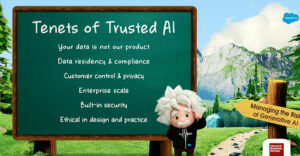
With the continued emergence of new technology and channels including social media, mobile, avatars and more, the relationship between brands and their customers and prospects has been changed forever. It’s interesting to consider the role of technology in these increasingly dynamic relationships. For some, it’s been an inhibitor; for others, a great catalyst.
Enterprise marketing technology helped many marketers make the initial shift from basic single- and multi-channel approaches, to adopting cross-channel marketing strategies. Once a relatively nascent market, cross-channel marketing used to be discussed in terms of consistency and coordination, as well as the value of a centralized data mart, and the importance of establishing a single marketing view of the customer and data. These attributes all signaled a dramatic shift from previous marketing strategies.
Today, we are on the verge of yet another important shift — to conversational marketing. Marketers who embrace this next phase, which is built on heightened interactivity and personalization, will be rewarded with customer share of mind and wallet.
How Conversational Marketing Is Different
Conversational marketing is about building and sustaining one-to-one personalized lifetime dialogues across all marketing channels to drive revenue and marketing effectiveness. It means unifying inbound and outbound communication strategies by tracking and managing all marketing activity data to generate targeted messaging, and by making the best, most relevant offers based on customer behavior and established preferences.
The term “conversational marketing” has been through an evolution over the past decade. In many ways, it was ahead of its time — a concept without the technology backing to make it a reality, and therefore considered “hype” in some circles. Social media adoption had just begun, and the marketing challenges related to channel diversity and customer expectations were just starting to show signs of modern-day complexity.
Perhaps one of the early influencers of the concept of conversational marketing is “The Cluetrain Manifesto: The End of Business as Usual.” First introduced in 1999, many of its lessons still ring true in today’s era of Facebook and Twitter and have inspired many other writings.
The Manifesto asserts that “networked markets are beginning to self-organize faster than the companies that have traditionally served them. Thanks to the web, markets are becoming better informed, smarter, and more demanding of qualities missing from most business organizations.”
What was missing? “The ability to converse as ‘humans.'” Several of the initial 95 theses in the manifesto include statements such as this: “Markets are conversations. Markets consist of human beings, not demographic sectors. The Internet is enabling conversations among human beings that were simply not possible in the era of mass media. As a result, markets are getting smarter, more informed, more organized. Participation in a networked market changes people fundamentally.”
Today, conversational marketing technology is available and capable of pushing the next phase of customer engagement — and human interaction — beyond previous boundaries.
Overcoming Channel Fragmentation
Success in conversational marketing endeavors is tightly linked to eliminating channel fragmentation and moving toward more coordinated inbound/outbound communications. Marketing platforms have traditionally focused on servicing and automating direct communications via “outbound” channels such as direct mail, email, mobile messaging and outbound telemarketing.
However, for the most part, they have not turned their attention to circumstances in which it is the individual who makes contact with the brand, on so called “inbound channels,” such as a website, a point of sale or a call center.
Inbound visitors usually have an intention — to learn about or buy a product or service, or to compare them with the competition. Study after study concurs that inbound visitors presented with a relevant offer are more inclined to respond, compared to recipients of direct outbound communications. Therefore, inbound contacts offer multiple, incremental opportunities to capture information about prospects and customers in real-time — and to make timely, relevant offers.
Increasing channel fragmentation has challenged marketers to utilize inbound interactions to drive marketing activities that ultimately result in better response rates. Marketers using outbound campaigns en masse know that the response rates today are very limited.
More mature marketers have moved to increasingly event-driven campaigns over time — and even to using transactional service messaging for marketing purposes. There are limits to these approaches, however, and consumers expect a deeper level of personalization and service when they interact with vendors.
As a result, marketers who continue to focus on the outbound “spray and pray” approach — which many still do — have created frustration with buyers. For inbound interactions, not coordinating past history results only aggravates customers who feel like their time is being wasted.
Developing Exceptional B2C Conversational Marketing Campaigns
In B2C organizations, conversational marketing technology should allow marketers to take every opportunity of contact with the individual to steer the right message and the right offer, via the right channel.
Mastering lifetime conversations hinges on the ability to master the “instant.” Conversational marketing technology must support individual value-creation journeys through a strong foundation of services that enable marketers to create and maintain a single, real-time marketing view of the customer.
In addition, there must be the capability to develop a centralized offer catalog and utilize a real-time recommendation engine that enables a unified offer strategy for steering and guiding individuals at every opportunity of contact. The real-time recommendation engine offers advanced simulation abilities to anticipate and prepare for interactions.
The recommendation engine is designed to generate individual messages containing the best offers for a given contact in a given context, and can be triggered by either inbound communications (website, call center, email) or outbound communications (email, direct mail, call center), so that all communications are fully consistent.
We are at an exciting marketing crossroads. Traditional single-, multi- and cross-channel marketing approaches are poised to evolve to the next level of customer engagement that is shaped by heightened interactivity and personalization.
With conversational marketing technology, marketers now have the critical tools and confidence necessary to fuse inbound and outbound channels, increase effectiveness and agility, and build sustainable one-to-one personalized lifetime dialogues.













































Social CRM
See all Social CRM